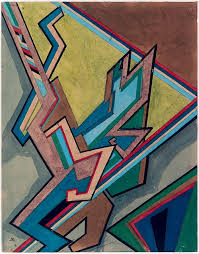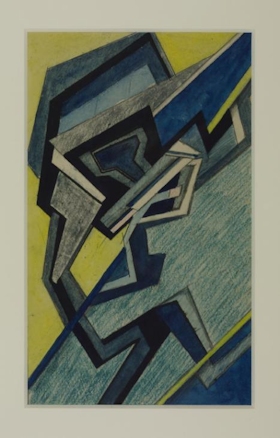
1885 - 1963
Helen Beatrice Saunders

description
An English avant-garde artist, a graphic illustrator, closely associated with British Vorticism. Together with Jessica Dismorr, she formed the “female” part of a group of 11 artists who signed the Vorticist Manifesto. Helen Saunders published her artwork, as well as poetry and prose in BLAST magazine. As a representative of early British Abstractionism, she became one of the first authors in the country working in a style very close to non-figurative, and she reached certain heights in this, developing her style in the mainstream of ideas of Post-Impressionism and Vorticism.
An important contribution of the artist to the social life of the country was her active support of the struggle to provide women with suffrage.
The non-durable Vorticist movement, initially often seen as a “muscular” manly affair, was supported by two women in such an innovative and compelling manner that so far none of the retrospective exhibitions dedicated to this Anglo-American movement could be held without their paintings. One of the largest ones, “Vorticists: rebel artists in London and New York, 1914-1918” (2011), was exhibited not only in the United States and Great Britain but also in Italy.
According to Helen Saunders, the movement represented “a very segmental group of artists, each of whom developed their ideas under the auspices of the vortex”.
Key ideas:
– The development of Saunders’ artistic talent began when she studied at the school of F. Slade; however, her early works testify to the rebellious nature of the talent of the aspiring artist. She was fascinated by the manner of Fauvists in its most crude form – very thick and seemingly sloppy contours, extremely conventional, often “broken” characters.
– Having joined the incredibly avant-garde movement, the artist used rigid geometry, which all the Vorticist artists used to a greater or lesser extent. Only a few of Saunders’ paintings and graphic drawings were completely abstract, and the figures of people or real objects were most apparent.
– The art of the artist of the Vorticist period is characterized by repeated, sometimes uneven diagonals and overlaps. The value of one’s feelings as the main aesthetic impulse, which W. Kandinsky wrote about, was important for Saunders, and this was almost the exact opposite position to the convictions of W. Lewis, the ideologist of Vorticism.
– The main feature of the works of Helen Saunders is in their fantastic, often intuitive colouristic solutions. The artist’s paintings of the time of the “whirlwind practice” that were considered lost were then found in the USA – the author selected them for an exhibition in New York, as she considered them complete and worthy of representing the British avant-garde in a new light.
– In the 1920s, the artist moved away from the position of avant-garde and worked in a manner close to realism. The paintings of the following periods, according to art critics, were not as interesting as the earlier ones.
1885
1906
1912
1914
1915
1916
1917
1921
1956
1963
The birth of the artist
Studied at the Slade School of Fine Arts

Participated in the collective exhibition of the Friday Club community

Saunders exhibited her paintings at Whitechapel Art Gallery's

Helen published her poems in BLAST Magazine

Joined the community of artists “London Group”

Worked on illustrations for the second and final issue of Explosion Magazine

Took part in the exhibition of the London group

«Wyndham Lewis and Vorticism»

The death of the artist

